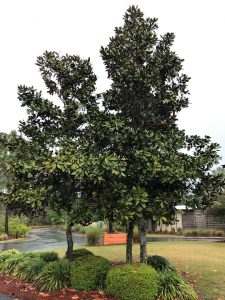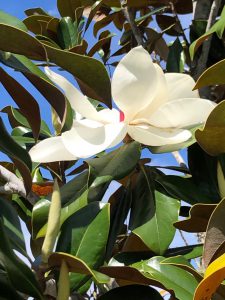There is a tall stately tree that can be found throughout the southeastern states, native in nature with a lustrous green leaf the southern magnolia is like no other tree. This amazing tree can be found from the edge of deep woodlands to the back of the tall sand dunes in the panhandle of Florida, all the way down the Florida Peninsula. The leaves provide a consistent evergreen providing a year-round presence in the landscape. Spring brings up small plate sized creamy white blooms with a wonderful fragrance with multiple blooms opening over 3 to 5 weeks. The magnolia can serve as a specimen tree or a back drop to allow other plants to be enjoyed.
Often the magnolia is envisioned to be this 80-foot tall by 40-foot-wide tree with an upright pyramidal shape with the branches reaching to the ground and up to 8-inch-long shiny green leaves. There are other shapes and sizes in the landscape industry that have been found in many different ways from seedling research that has taken place at several of our land grant universities including the University of Florida. Other magnolia with different growth and bloom habits have been found growing in nature. Below are a few of these exceptional species that were selected by the keen eye of a nurseryman or a plant specialist. Next come decades of field grown observation to determine if the plant characteristics are consistent with cuttings taken and rooted to grow more trees. This is one way to see if the same look and growth continues in multiple plants.
If you grow trees from collected seeds, the new seedlings will show variable growth patterns and likely not present a consistent growth or leaf form from tree to tree. This is the reason for taking cuttings from a magnolia with the desired growth habit, leaf size and color, bloom color and fragrance.
Several cultivars have risen to the top in popularity in the landscape industry over the last 30 to 40 years. One of the most popular large magnolias is ‘Bracken’s Brown Beauty’. It was selected in a seedling field when one of the universities had completed research and invited a local nurseryman to come take any he wanted before the field was turned under for other plant research. Many were dug and field planted at the nursery with one showing many desired characteristics. With its dark rusty brown lower leaf and deep green top. It was observed for a number of years with cuttings taken. One major observation was its tolerance to cold weather. They had a winner and began to introduce it into the plant industry. ‘Little Gem’ is another magnolia that is quite popular for its dwarf (slower) upright growth habit. It first was considered a hedge plant with a dense leaf canopy from bottom to top. The challenge is the plant density opens up as it matures with it ultimately reaching approximately 30-foot tall by 20-foot wide. The surprising part of this smaller magnolia is its bloom is similar in number, yet 3 to 5 inches in size in large numbers as the other southern magnolias. Next there is a few weeks rest period and then sporadically blooms all summer and early fall. There are so many magnolias that could be mentioned I just don’t have enough article space, so it will stop with ‘Claudia Wannamaker’. This magnolia is an old stand by that has been found to be moderately salt tolerant and can be found growing near coastal settings. The leaf wax layer is slightly thicker allowing for a little more protection from the salt. It has a more open multi-truck growth allowing for wind to pass through more easily. The challenge is finding one in the landscape industry.
Contact your UF IFAS Extension office in your county with questions. Enjoy this wonderfully unique tree.
- Deer Damage in the Landscape - February 22, 2024
- Gardeners: A Critical Link to Protecting Our Water - January 18, 2024
- Propagating Plants by Leaf and Cane - December 14, 2023


